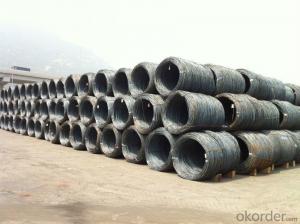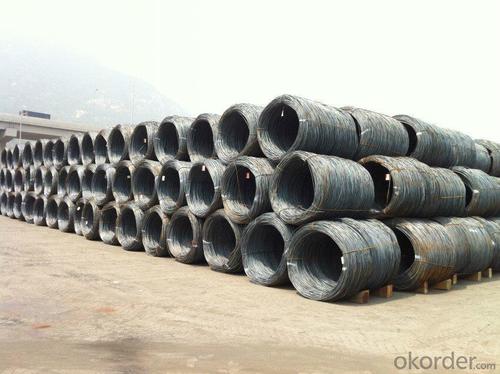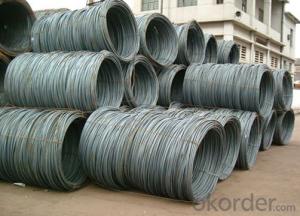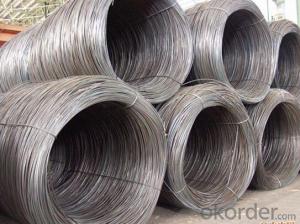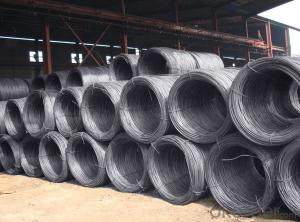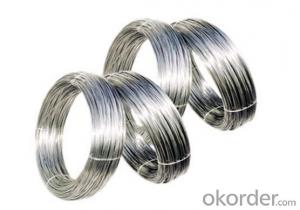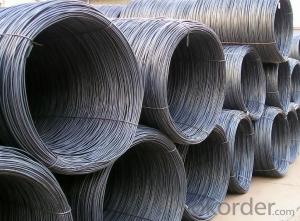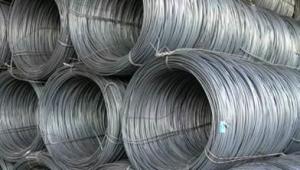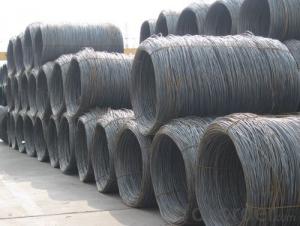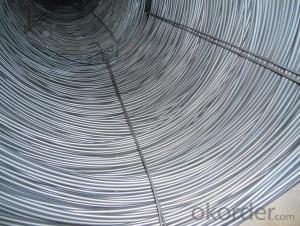SAE1008 Wire Rod ,5.5mm steel wire rod,hot rolled Wire Rod for sale
- Loading Port:
- Tianjin
- Payment Terms:
- TT OR LC
- Min Order Qty:
- 50 m.t.
- Supply Capability:
- 5000 m.t./month
OKorder Service Pledge
OKorder Financial Service
You Might Also Like
Specification
Specifications of Steel Wire Rod in Coil:
Steel Grade: Q195/235, SAE1006-1018B Standard: ASTM, GB
Diameter: 5.5mm, 6.5mm, 7mm,8mm,9mm,10mm,12mm,14mm
Type: Drawn Wire Alloy or Not: Alloy Brand Name: HSKY
Technique: Hot Rolled Place of Origin: China Mainland
Chemical Composition:(Please kindly find our chemistry of our material based on SAE1006B and SAE1008B as below for your information)
High carbon/Low carbon/common carbon Steel wire rod | With boron for rebate tax |
Grade | SAE1006B SAE1008B SAE1018B |
Package | In coil ,in bundle, |
Coil weight | about 2000kg-3000kgs |
Size: | 5.5mm 6.5mm 8mm 10mm 12mm 14mm 16mm |
Types | High Carbon ,Low carbon ,Common carbon |
Exported Country | South Korea,Vietnam,Indonesia,Myanmar,Philippines and Afrca,Ect |
Delivery term: | within 30 days after receive the LC |
Payment Term: | LC at sight ,LC 30-120 days after B/L date, TT payment |
The Standard of Physical Properties:
Grade | Chemical Composition(%) | |||||
C | Mn | Si | S | P | Cr | |
SAE1006 | 0.03~O.07 | ≤0.32 | ≤0.30 | ≤0.045 | ≤0.040 | >0.30 |
Mechanical properties | ||||||
Yield strength(N/mm2) | Tensile strength(N/mm2) | Elongation(%) | ||||
250-280 | 350-380 | ≥32 | ||||
Grade | Chemical Composition(%) | |||||
C | Mn | Si | S | P | Cr | |
SAE1008 | 0.10max | 0.3~O.50 | 0.15max | 0.050max | 0.040 max | 0.30 min |
Mechanical properties | ||||||
Yield strength(N/mm2) | Tensile strength(N/mm2) | Elongation(%) | ||||
≥195 | 315-430 | ≥30 | ||||
Usage and Applications of Steel Wire Rod in Coil:
After hot-rolled the products shaped into coil and delivery as finished product, including round, square, rectangular, hexagonal and so on, Since most of the products are round, it is generally called wire rod. Steel wire rod is widely used in construction and manufacturing. Steel wire rod is mainly used for reinforcement of reinforced concrete and welded structure or reprocessed (roberts, nail etc) materials, especially used to produce wire drawing, welding electrode, nails,spring, electronic, precise machinery parts and so on.
Packaging & Delivery of Steel Wire Rod in Coil:
Packaging Detail: products are packed in coil and then shipped by container or bulk vessel
Each coil weight: 2-3MT
Delivery Detail: within 45 days after received deposit or LC.
Label: to be specified by customer, generally, each bundle has 1-2 labels
Trade terms: CFR, CIF

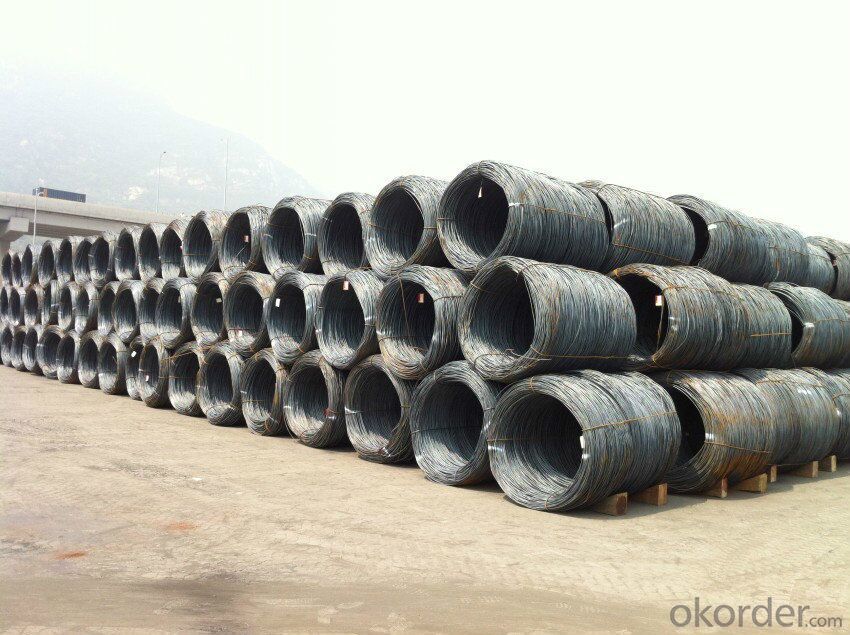
- Q: What are the different types of steel wire rod annealing processes?
- There are several different types of steel wire rod annealing processes used in the industry. These processes are designed to improve the mechanical properties and overall quality of the steel wire rod. 1. Full Annealing: This process involves heating the steel wire rod to a high temperature and then slowly cooling it down to room temperature. This allows for the complete transformation of the steel's microstructure, resulting in improved ductility and toughness. 2. Isothermal Annealing: In this process, the steel wire rod is heated to a specific temperature and held at that temperature for a certain period of time. This allows for the formation of a uniform microstructure throughout the wire rod, resulting in improved mechanical properties. 3. Spheroidizing Annealing: This process is specifically used for high-carbon steel wire rods. It involves heating the wire rod to a temperature just below its melting point and holding it at that temperature for a prolonged period of time. This allows for the formation of small spheroidal carbides within the microstructure, resulting in improved machinability and formability. 4. Process Annealing: This annealing process is used to relieve internal stresses and improve the cold-working properties of the steel wire rod. It involves heating the wire rod to a specific temperature and then cooling it rapidly, typically in water or air. 5. Normalizing: Normalizing is a type of annealing process that involves heating the steel wire rod to a temperature slightly above its upper critical temperature and then cooling it in still air. This process helps to refine the grain structure of the steel, resulting in improved strength and toughness. Overall, these different types of steel wire rod annealing processes are used to tailor the mechanical properties of the steel to meet specific requirements for various applications.
- Q: What are the main factors affecting the market forecasts of steel wire rod?
- The main factors affecting the market forecasts of steel wire rod include global demand and supply dynamics, economic growth and industrial activity, raw material prices and availability, technological advancements, government regulations and policies, and competition within the industry. Additionally, factors such as geopolitical events, currency fluctuations, and environmental considerations can also influence market forecasts for steel wire rod.
- Q: How does the electrical conductivity of steel wire rod vary with different grades?
- Differences in the composition and microstructure of steel lead to variations in the electrical conductivity of steel wire rod across different grades. Typically, steel wire rod is produced using carbon steel, an alloy of iron and carbon. However, the electrical conductivity can be influenced by the presence of other elements like manganese, silicon, and various alloying elements, which vary in quantity among different grades of steel. In general, higher carbon content in steel diminishes its electrical conductivity. This occurs because carbon atoms obstruct the movement of electrons, making it more challenging for electricity to flow through the material. Moreover, the existence of impurities or other alloying elements also affects the electrical conductivity of steel wire rod. For instance, elements such as phosphorus, sulfur, and oxygen introduce impurities that hinder electron flow, thereby decreasing conductivity. Furthermore, the microstructure of steel, including the presence of grain boundaries, also impacts electrical conductivity. Grain boundaries act as barriers to electron flow, ultimately reducing conductivity. Hence, when assessing the electrical conductivity of steel wire rod, it is crucial to consider the specific grade. Varied carbon content, impurities, and microstructural attributes all contribute to the disparities in electrical conductivity among different grades of steel wire rod.
- Q: How is steel wire rod used in the manufacturing of wire trays?
- Steel wire rod is used in the manufacturing of wire trays as it is the primary material required to create the wire mesh structure of the tray. The steel wire rod is processed and shaped into the desired dimensions and then woven or welded together to form the sturdy and durable wire mesh that makes up the tray. This wire mesh structure allows the tray to hold and organize various items securely, making it an essential component in wire tray manufacturing.
- Q: How is steel wire rod used in the manufacturing of suspension bridges?
- Steel wire rod is used in the manufacturing of suspension bridges primarily for the construction of suspension cables. These cables provide the primary support for the bridge deck, carrying the weight of the entire structure and distributing the load evenly. The high strength and durability of steel wire rod make it an ideal material for these cables, ensuring the bridge's stability and ability to withstand heavy loads and dynamic forces.
- Q: What are the main factors affecting the market consolidation of steel wire rod?
- The main factors affecting the market consolidation of steel wire rod include global demand and consumption patterns, price fluctuations and competition, technological advancements, government regulations and policies, and the overall economic conditions. Additionally, factors such as mergers and acquisitions, industry restructuring, and the presence of major players in the market also contribute to the consolidation process.
- Q: What are the main challenges in steel wire rod production?
- There are several main challenges in steel wire rod production that manufacturers typically face. One of the primary challenges is ensuring consistent quality and uniformity in the wire rod products. Since steel wire rods are used in various applications such as construction, automotive, and manufacturing industries, it is crucial to maintain strict quality control measures to meet the specific requirements and standards of each sector. Another significant challenge is optimizing the production process to achieve high productivity and efficiency. Steel wire rod production involves multiple stages, including melting, casting, rolling, and finishing. Each stage requires proper equipment, skilled operators, and precise control to minimize downtime, reduce waste, and maximize output. Manufacturers must continuously analyze and refine their production processes to achieve optimal efficiency. Furthermore, the global steel industry faces environmental challenges, including reducing energy consumption, minimizing carbon emissions, and implementing sustainable practices. Steel wire rod production consumes significant energy, especially during the melting and rolling processes. Manufacturers are constantly exploring innovative technologies and methods to improve energy efficiency, recycle waste materials, and reduce the environmental impact of their operations. Supply chain management is another critical challenge in steel wire rod production. Manufacturers need to ensure a steady supply of raw materials, such as iron ore and scrap metal, and maintain strong relationships with suppliers. Additionally, they must manage logistics efficiently to deliver finished products to customers promptly and reliably. Lastly, the steel wire rod market is highly competitive, with numerous domestic and international players. Manufacturers must continuously innovate and adapt to market trends, customer demands, and changing regulations to remain competitive. They need to invest in research and development, product diversification, and marketing strategies to differentiate themselves and maintain a strong market position. In summary, the main challenges in steel wire rod production revolve around quality control, production efficiency, environmental sustainability, supply chain management, and market competitiveness. Overcoming these challenges requires continuous improvement, technological advancements, and strategic decision-making to ensure success in this demanding industry.
- Q: How is steel wire rod used in the manufacturing of fasteners?
- Steel wire rod is used in the manufacturing of fasteners as it provides the necessary strength and durability required for holding materials together. It is typically drawn into various diameters and then cut, threaded, or shaped to form different types of fasteners such as bolts, screws, nails, and rivets. The high tensile strength of steel wire rod ensures that the fasteners can withstand the applied forces and securely fasten components in various industries including construction, automotive, and aerospace.
- Q: What are the applications of steel wire rods?
- Steel wire rods are widely used in various applications due to their strength, flexibility, and durability. Some of the common applications of steel wire rods are: 1. Construction: Steel wire rods are extensively used in the construction industry for reinforcing concrete structures. They are used to create steel mesh, stirrups, and rebar, which significantly enhance the strength and stability of concrete buildings, bridges, and other infrastructure. 2. Automotive industry: Steel wire rods are indispensable in the automotive sector. They are used to manufacture springs, suspension systems, tire reinforcement, and seat frames, providing the necessary strength and resilience for various automotive components. 3. Manufacturing: Steel wire rods are utilized in the manufacturing of a wide range of products such as nails, screws, bolts, and wire mesh. These products find applications in the construction industry, furniture manufacturing, and general fabrication processes. 4. Electrical industry: Steel wire rods are employed in the electrical industry for the production of cables and conductors. They form the core of electrical cables, ensuring the efficient transmission of electricity over long distances. 5. Agricultural sector: Steel wire rods are used in the agricultural sector for fencing and animal enclosures. They provide a strong and durable barrier, ensuring the security and safety of livestock and crops. 6. Packaging industry: Steel wire rods are utilized in the packaging industry for the production of wire-based packaging materials such as wire baskets, racks, and crates. These products provide a sturdy and reliable solution for transporting and storing various goods. 7. Wire products: Steel wire rods are also transformed into a wide array of wire products, including wire ropes, springs, piano wires, and welding electrodes. These products find applications in diverse industries such as mining, marine, manufacturing, and construction. In summary, the applications of steel wire rods are vast and diverse, ranging from construction and automotive to manufacturing and electrical industries. Their strength, flexibility, and durability make them indispensable in numerous sectors, playing a crucial role in enhancing the performance and reliability of various products and structures.
- Q: What are the different storage methods for steel wire rod?
- There are several different storage methods for steel wire rod, including coil storage, bundle storage, and pallet storage. Coil storage involves stacking the wire rod coils on top of one another, either vertically or horizontally. Bundle storage involves tying multiple wire rod bars together in a bundle and storing them on racks or shelves. Pallet storage involves placing the wire rod coils or bundles on pallets and storing them in a warehouse or storage facility. Each method has its own advantages and is chosen based on factors such as space availability, ease of access, and transportation requirements.
Send your message to us
SAE1008 Wire Rod ,5.5mm steel wire rod,hot rolled Wire Rod for sale
- Loading Port:
- Tianjin
- Payment Terms:
- TT OR LC
- Min Order Qty:
- 50 m.t.
- Supply Capability:
- 5000 m.t./month
OKorder Service Pledge
OKorder Financial Service
Similar products
Hot products
Hot Searches
Related keywords
